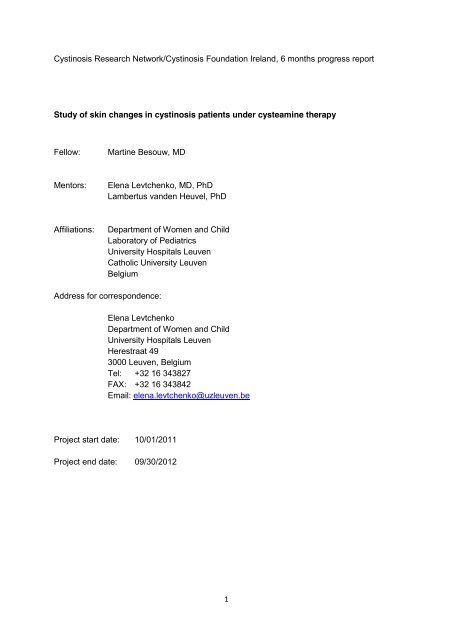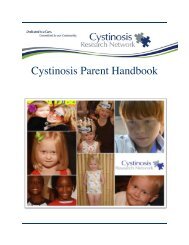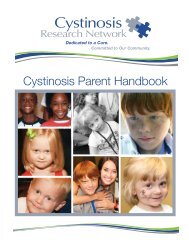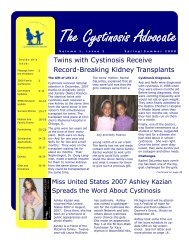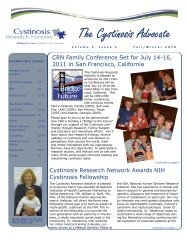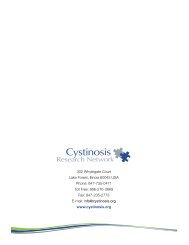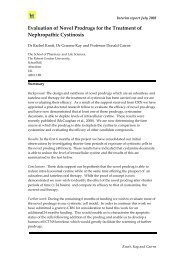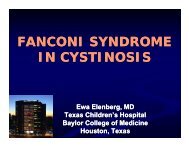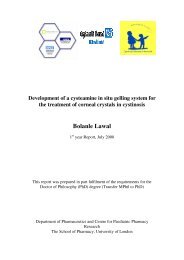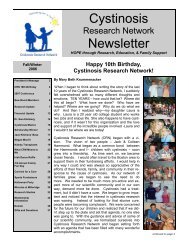Progress Report - Cystinosis Research Network
Progress Report - Cystinosis Research Network
Progress Report - Cystinosis Research Network
- No tags were found...
Create successful ePaper yourself
Turn your PDF publications into a flip-book with our unique Google optimized e-Paper software.
<strong>Cystinosis</strong> <strong>Research</strong> <strong>Network</strong>/<strong>Cystinosis</strong> Foundation Ireland, 6 months progress reportStudy of skin changes in cystinosis patients under cysteamine therapyFellow:Martine Besouw, MDMentors:Elena Levtchenko, MD, PhDLambertus vanden Heuvel, PhDAffiliations:Department of Women and ChildLaboratory of PediatricsUniversity Hospitals LeuvenCatholic University LeuvenBelgiumAddress for correspondence:Elena LevtchenkoDepartment of Women and ChildUniversity Hospitals LeuvenHerestraat 493000 Leuven, BelgiumTel: +32 16 343827FAX: +32 16 343842Email: elena.levtchenko@uzleuven.beProject start date: 10/01/2011Project end date: 09/30/20121
BackgroundRecently 8 cystinosis patients who were treated with relatively high doses of cysteaminewere reported to develop a new type of adverse events consisting of skin striae onstretchable surfaces of extremities, bruising-like lesions on the elbows and severe muscularskeletalpain and weakness. Side effects, and in particular skin lesions, diminished ordisappeared after cysteamine dose reduction, pointing to a causal relation betweencysteamine administration and the appearance of the lesions. Skin biopsies of the bruisinglikelesions showed vascular proliferation also called reactive angioendotheliomatosis on lightmicroscopy. Electron microscopy showed irregularities and variability in collagen fibercaliber, closely resembling the collagen alterations that are seen in classical Ehlers-Danlossyndrome (EDS). 1We hypothesized that cysteamine causes skin lesions via inhibition of collagen cross-linking.This effect can be due to a direct interaction of cysteamine with collagen aldehydes that arerequired for stable cross-link formation, or might be due to an inhibition of the enzyme lysyloxidase, which is responsible for the formation of these aldehydes. As copper is a co-factorof lysyl oxidase, 2 copper deficiency can contribute to the adverse effect of cysteamine.Furthermore, differences in cysteamine metabolism between individuals can be responsiblefor higher tissue cysteamine concentrations and underlie cysteamine toxicity in a subset ofpatients.Specific aimsThe etiology of collagen fibre abnormalities in cystinosis patients with cysteamine toxicityremains unknown. The process of collagen synthesis and degradation is under strictphysiological control. Cysteamine might either directly influence the synthesis ofprocollagens, or interfere with collagen cross-linking, which occurs extracellular. Collagencross-link formation is catalyzed by the enzyme lysyls oxidase, wich uses copper as a cofactor.2 Therefore, copper deficiency might further contribute to the adverse effect ofcysteamine. With this project, we aim to study the etiology behind collagen abnormalities incystinosis patients with cysteamine toxicity.Key-objectives/work planA. To analyze a possible effect of cysteamine on collagen synthesis in cultured skinfibroblasts.B. To analyze a possible effect of cysteamine on urinary deoxypyridinoline andpyridinoline levels, as a measure of bone collagen cross-linking and bone turnover.C. To measure plasma copper and ceruloplasmin levels in European cystinosis patients.D. To analysis of possible genetic polymorphisms in ATP7A gene in patients withcysteamine toxicity.E. To study cysteamine metabolism in a skin biopsy obtained from a cystinosis patient,treated with cysteamine.2
ResultsA. We have investigated a possible effect of cysteamine on collagen synthesis infibroblasts obtained from cystinosis patients with (n=3) and without (n=2) cysteaminetoxicity. All 6 fibroblast cell lines will be cultured both with and without cysteamine 0.1mM (which equals patients’ peak plasma concentration). Different (pro)collagens(type I and type III) produced by these fibroblasts were analysed using gelelectroforesis. These include the collagen medium fraction, the collagen cellularfraction and the procollagen fraction. We found normal synthesis of all collagenfractions of all tested fibroblasts (figure 1). Also, the addition of 0.1 mM cysteaminedid not influence (pro)collagen synthesis.Figure 1. Collagen medium fraction, collagen cellular fraction and procollagen fraction were comparedin fibroblasts obtained from patients with (n=3) and without (n=2) cysteamine toxicity. There we nodifferences between both groups.B. Study is currently in progress.C. Thirty-five cystinosis patients were included: 21 with renal Fanconi syndrome(including 6 with cysteamine toxicity), 12 after renal transplantation, 1 onhemodialysis and 1 with ocular cystinosis. Serum copper, ceruloplasmin and urinarycopper/creatinine ratio were determined.Results are shown in figure 2. All patients with renal Fanconi syndrome hadincreased urinary copper excretion. In the transplanted patients, only 3/12 patientsshowed increased urinary copper/creatinine ratio. This difference was statisticallysignificant (p
Figure 2. Comparison of serum copper levels (A),serum ceruloplasmin levels (B) and urinarycopper/creatinine ratio (C) between patients withrenal Fanconi syndrome and after renaltransplantation, and correlation between serumcopper and serum ceruloplasmin (D). Patients withcysteamine toxicity are indicated in black, thepatient with ocular cystinosis is indicated in lightgrey, the anuric patient on hemodialysis isindicated in dark grey. The red asterix indicates astatistically significant difference (p
Reference List1. Besouw MT et al. Cysteamine toxicity in patients with cystinosis. J Pediatr(2011):159;1004-1011.2. Siegel RC, Pinnell SR, Martin GR. Cross-linking of collagen and elastin. Properties oflysyl oxidase. Biochemistry (1970):9;4486-4492.5


